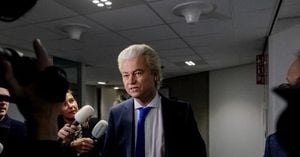Poland is taking significant steps to combat the ongoing bird flu crisis, presenting a detailed 14-point plan to the European Commission (EC) aimed at curbing the alarming number of outbreaks within its borders. As of now, Poland has reported nearly 80 confirmed cases, the highest in the European Union, prompting concerns at the EU level about the potential for wider restrictions.
On April 15, 2025, European Commission spokesperson Eva Hrnczirzova announced that the Commission had engaged in a constructive technical meeting with Polish authorities regarding national emergency measures. Following this dialogue, the EC acknowledged Poland's proposed actions, particularly those targeting the Mazovia and Wielkopolska regions, and confirmed that no additional EU-wide restrictions would be implemented at this time.
Minister of Agriculture Robert Siekierski emphasized the importance of the 14-point plan, which includes stringent biosecurity measures and adjustments to farming practices designed to mitigate the risk of further outbreaks. "This proposal was developed in collaboration with poultry producers organized within the National Chamber of Poultry Farming and has been accepted by the Veterinary Inspection," he stated, highlighting the collaborative effort behind the initiative.
The plan outlines several key actions, including extending the time intervals between breeding cycles and increasing the size of risk zones surrounding confirmed outbreaks. Specifically, the endangered area will expand by an additional five kilometers, up from the current seven kilometers, whenever a case is confirmed. These measures are intended to strengthen biosecurity protocols and ensure that poultry farming practices are in line with health safety standards.
Despite the proactive measures being proposed, the European Commission has noted that Poland is not fully adhering to existing biosecurity regulations, which has contributed to the persistence of new outbreaks. This situation has raised alarms as nearly 200 cases of bird flu have been reported across the EU, with Poland accounting for a significant portion.
According to Siekierski, the poultry sector is bracing for potential impacts on egg prices due to the bird flu situation, which has already seen a seasonal increase in costs. He reassured consumers, stating, "While prices have risen, this is a seasonal increase, not indicative of a permanent trend. Poland remains a significant poultry producer with a robust egg export market, ensuring a stable supply for consumers." He also mentioned that prices are expected to be adjusted post-holidays.
The poultry industry has expressed optimism regarding the measures being implemented. Paweł Podstawka, president of the National Federation of Poultry Breeders and Egg Producers, characterized the acceptance of the bird flu control plans by the EC as a victory for the industry. He noted, "We have prepared a cohesive package of actions that consider the realities of farming, food safety, and the need to combat poultry diseases. This is a collective success, demonstrating the value of uniting experts, breeders, and government representatives to advocate for our interests."
In the wake of these developments, the EC has committed to closely monitoring the situation for any further outbreaks. Should additional cases arise, further discussions will be necessary to determine the next steps. The Commission's decision to forgo immediate restrictions reflects a willingness to work collaboratively with Poland in addressing the bird flu crisis.
As the warmer months approach, concerns about the re-emission of the virus remain. Experts have noted that the virus is most active during the autumn and winter, and any changes in weather patterns could influence its spread. The poultry sector is thus on high alert, ready to adapt to any evolving circumstances.
Overall, the cooperative efforts between Polish authorities and the poultry industry aim to safeguard both public health and the economic viability of poultry farming in Poland. The implementation of these measures is seen as crucial in preventing future outbreaks and maintaining the integrity of the poultry supply chain.





